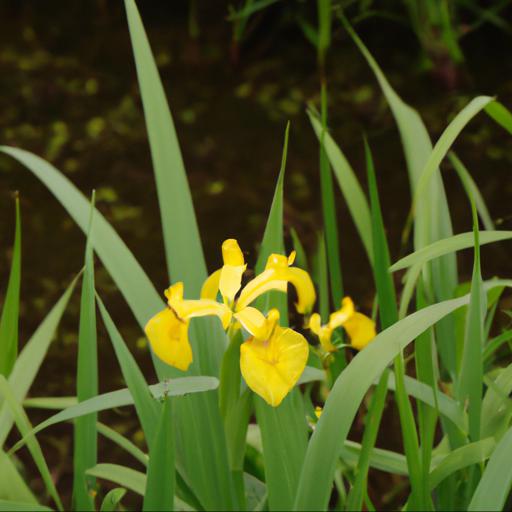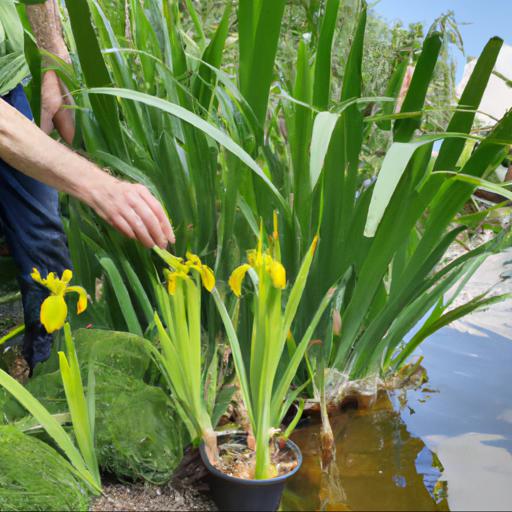Iris pseudacorus, commonly known as Yellow Flag Iris, is a species of flowering plant in the family Iridaceae. Native to Europe and Asia, this beautiful flowering plant is a popular choice for gardeners and landscapers alike. Not only is it a stunning addition to any garden, but it’s also a hardy plant that can tolerate a wide range of conditions.
In this blog post, we’ll take a closer look at the unique characteristics of Iris pseudacorus and explore how to best care for it in your garden.
Characteristics of iris pseudacorus

Iris pseudacorus, often referred to as yellow flag iris, is a native plant to many parts of Europe and America. It is an incredibly hardy and easily grown marsh plant that can thrive in poor soils and wet environments.
This plant has a large root system, which allows it to spread quickly across large areas. It is an attractive and hardy option for gardeners and can be used to add natural beauty to lakesides, wetlands, and other parts of the garden, making it an attractive option for amateur and professional gardeners alike. Iris pseudacorus is a tall, resilient plant that can grow between 1 to
5 meters high. It is typically identified by its striking yellow flowers and sword-shaped leaves.
Its blooming season runs between early spring to late summer, when its yellow flowers appear and gives a charming touch to the garden. These yellow flags are borne in clusters, giving a unique addition to any landscape. The sword-shaped leaves can then remain in place all year round, giving a robust structure and continuous presence to the garden.
Due to its hardy characteristics, Iris pseudacorus can grow with ease in difficult conditions. It can be found growing in or around untreated wastewater, streams, drainage channels, and other lesser-managed habitats as well as in gardens.
This plant has adapted so well to difficult conditions that it has been classified as an invasive species in some areas. It is incredibly difficult to eradicate once it has become established in an area and so it is important for gardeners to be aware of this characterstic before planting. Overall, Iris pseudacorus, is a great option for gardeners looking for a resilient and hardy flower to add some unique yellow colour to their landscapes, however they must be wary to not introduce this species to areas where it has the potential to become invasive.
Benefits of growing iris pseudacorus

As a UK garden expert, I wish to share some of the advantages that come from growing the Iris pseudacorus species of flower. This iris species, commonly known as the yellow flag, contributes bright yellow blooms to any garden design and is fairly resilient, making it a powerful choice for garden owners. Firstly, by planting the Iris pseudacorus you can bring a unique touch to your garden.
The yellow flags are showstoppers with their deep yellow color, which makes them stand out in any garden. Moreover, their unique shape and their flowers’ light petals make them instantly recognizable.
As the Iris pseudacorus are particularly tolerant of wet soils, they can easily handle regular rainfall and still manage to look their best. Another great advantage of cultivating the Iris pseudacorus comes from their ease of care.
This species of iris is able to stay strong and resist common garden pest, making them an ideal choice for gardeners who prefer a minimal maintenance approach. This species of iris does best when planted in full sunlight and watered occasionally. Furthermore, by cutting back the deadheaded stems in the fall will encourage new growth for the upcoming season.
In conclusion, Iris pseudacorus is a hearty, versatile plant that can make a great addition to any UK garden. Their bright yellow colour, low maintenance care needs, and ability to adapt to changing environments make them the ideal choice for busy gardeners.
The Iris pseudacorus are not only visually stunning, but they also bring a unique touch to any garden design.
How to plant and care for iris pseudacorus

As a UK garden expert, I am often asked about the best way to plant and care for the yellow-flowered Iris pseudacorus. This vibrant perennial is a popular choice for UK gardens, and with a little bit of love and care, it is sure to thrive.
When planting Iris pseudacorus, it is important to choose a sunny location with moist, well drained soil. To achieve this, consider amending the soil prior to planting with some compost, to give your plants the best start. Although a relatively hardy plant, you should take care when handling young plants and avoid overwatering, as this could cause the foliage to rot.
Once planted, you should water it regularly and provide protection from too much sun or cold. The addition of an organic mulch in spring can also be beneficial, to help retain soil moisture, although you should avoid burying the stems. In addition, it is important to deadhead the flower stems after bloom to encourage further flowering and also to remove any dead or damaged foliage in the same season to maintain its good health.
Iris pseudacorus is fairly drought tolerant, but you should water your plants throughout the growing season to promote healthy growth. For best results, fertilise your plants with a balanced slow-release fertiliser at the start of the season and use a net to protect them from slugs or snails.
With a little TLC, this hardy, vibrant plant is sure to bring a burst of colour to your UK garden.
Common pests and diseases of iris pseudacorus
Iris pseudacorus, or yellow flag iris, is a beautiful flowering plant that is commonly found in wetlands and other damp areas in the UK. But unfortunately, this lovely iris has several pests and diseases which can affect its growth and well-being.
Knowing how to identify, deal with, and hopefully prevent these issues is an important part of keeping yellow flag iris happy and healthy in your garden. The most common pest to affect yellow flag iris is slugs – these slimy pests love to munch on the foliage and flowers of the plant. Slugs can be managed in a number of ways, such as keeping the area around the iris well-maintained, introducing predators like hedgehogs and frogs, or applying slug pellets or a more natural method, such as copper rings.
Another common nuisance is aphids – the small, green bugs that feed on plant sap, often found in large colonies on iris leaves. Monitor for aphids regularly, as they can weaken the plant and potentially lead to other problems like a fungal infection.
If you spot signs of an aphid infestation, spray your iris with soapy water or introduce a few ladybugs, which will help to keep the population under control. Finally, yellow flag iris is vulnerable to fungal infections like botrytis, which usually form on wet or damp leaves. These fungal infections, often referred to as ‘grey mould’ due to their fluffy white colour, can be controlled by removing infected leaves, using a fungicide or by improving air circulation around the plants.
In conclusion, knowing how to care for your yellow flag iris, and dealing with any pests or diseases quickly and effectively, is key to ensuring it has the best chance of thriving in your garden. Keeping an eye on it regularly, and taking action to maintain a clean and hygienic environment around it will help to protect it from any issues.
Our video recommendation
Bottom Line
Iris pseudacorus, commonly known as Yellow Flag Iris, is a species of flowering plant native to Europe, western Asia, and northwest Africa. It is a popular ornamental plant and is often found in water gardens or near ponds and streams.
The plant is known for its bright yellow flowers and its ability to survive in wetland habitats. It is also a popular choice for use in naturalizing landscapes and is often used to control erosion.
FAQ
What is the scientific name of Iris pseudacorus?
The scientific name of Iris pseudacorus is Iris pseudacorus L.
Where is Iris pseudacorus natively found?
Iris pseudacorus is natively found in Europe, western Asia, and northwest Africa.
What are the common names for Iris pseudacorus?
The common names for Iris pseudacorus are Yellow Flag Iris, Yellow Iris, Water Flag, and Yellow-Flowered Iris.
What are the characteristics of Iris pseudacorus?
Iris pseudacorus is a wetland plant with bright yellow flowers and sword-shaped leaves. It is a hardy, evergreen perennial that grows up to 1.5 meters in height. It is tolerant of a wide range of soil types and can tolerate periods of flooding. It is also tolerant of salt and can be found in coastal areas. It is a fast-growing plant and can spread quickly, making it an ideal choice for naturalizing areas of wetland.
How is Iris pseudacorus used in landscaping?
Iris pseudacorus is used in landscaping to add color and texture to gardens and ponds. It is a hardy, water-loving plant that can tolerate wet soils and is often used as a marginal plant in water gardens. It also provides cover and food for wildlife.
What are the potential risks of planting Iris pseudacorus?
The potential risks of planting Iris pseudacorus include the potential for it to become invasive and outcompete native species, as well as the potential for it to spread to water bodies and cause water pollution.

